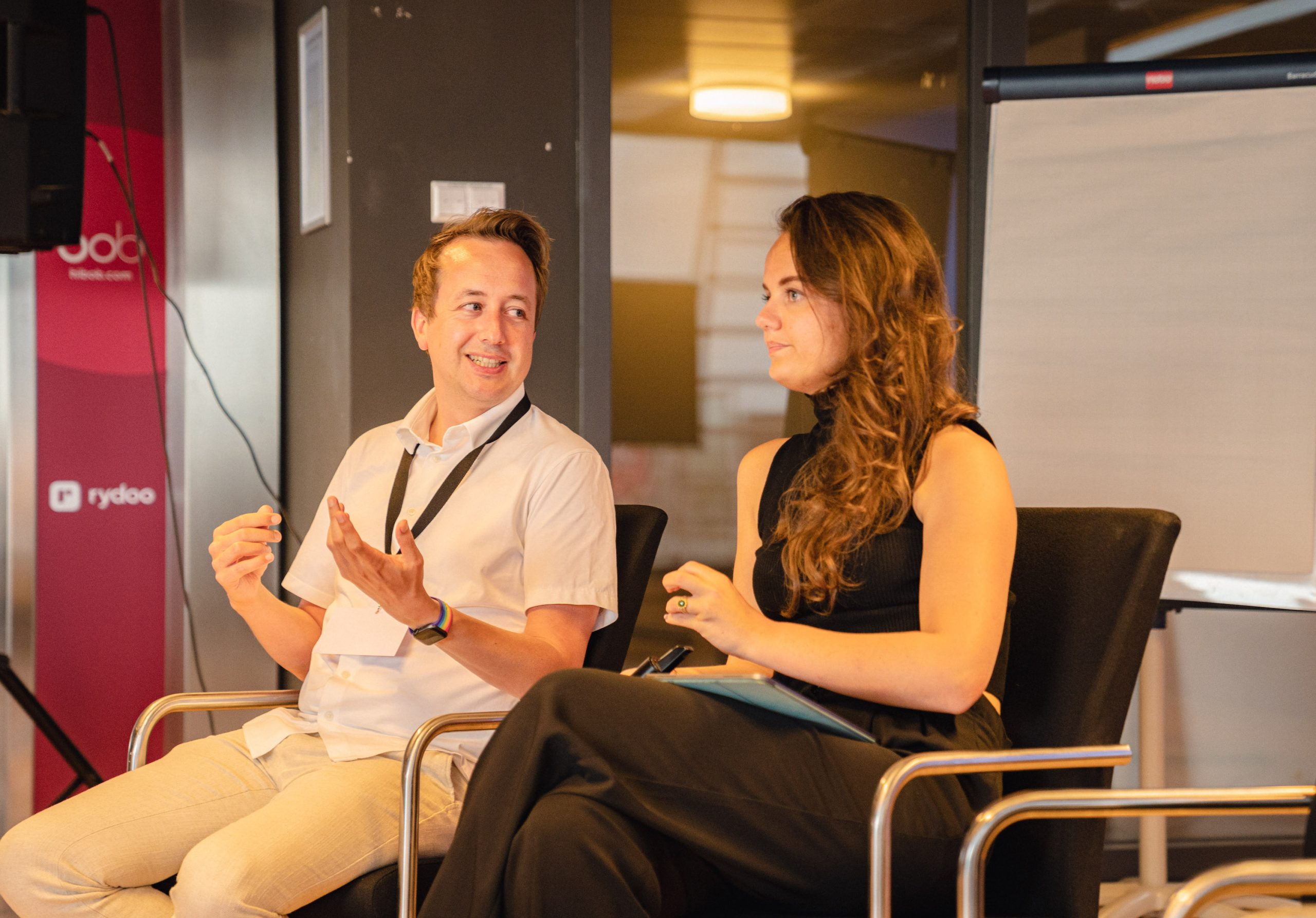The war for talent is on, Forbes wrote back in June 2023. In just a few short years, it went from being just something that could potentially happen to a reality most companies will have to face sooner rather than later.
According to a report by Korn Ferry, by 2030, more than 85 million jobs could go unfilled because there aren’t enough skilled people to take them. In a world where uncertainty rules, the economic market keeps on shifting and it has become more important than ever to retain the right talent, how can organisations maintain their employees and still manage to keep their costs at bay?
As Pleun Opperman, Co-CEO of Parakar Group, said during a live panel in Amsterdam, being transparent and allowing teams to voice their concerns, providing them with the guidance they need, is half the battle.
“If I’m asking my leaders to make decisions by only making parts of information available to them, it’s not going to work”, Opperman said. “I need to allow them to have full transparency and opportunity to share their dilemmas, their issues, the things that they want to see happen in the future.”

On the other hand, Raymond Hannes, founder of , believes a sense of magic can come into play by investing in the right tools. This magic, Hannes believes, can be the fuel to ignite the fire of creativity, productivity and happiness amongst employees.
“Sometimes things have magic, and I think we should not ignore that”, says the business director. “Somehow, some kind of magic seeps into your company and the creativity increases. Your productivity increases. And you retain more talent.”
Opperman and Hannes joined Sophie Vandriessche, CRO at Rydoo and Yoss Perl, Regional Sales Director from HiBob in the Netherlands for a conversation on cutting costs whilst still putting people first, where they discussed transparency, but also the new work models and the importance of not only retaining talent, but investing in it.
Embracing Transparent Communication and Decision-Making
In the dynamic business landscape of today, transparent communication has become not only necessary but essential. In leadership roles, embracing openness is the bedrock for fostering trust, spurring innovation, and knitting together a cohesive organisational fabric that stands resilient amidst challenges. Pleun Opperman experienced this first-hand when she became the CO-CEO of the Parakar Group. After becoming a part of the executive team of such a large group, Pleun struggled with managing people from different generations and retaining talent in a sustainable way.
“I felt like I needed to have all the answers, I needed to know everything and be a strong leader so that my team could rely on me”, Pleun recalls. She had access to all of this information about the organisation but the truth was that not everyone had the same privilege. According to Pleun, that had to change, fast. “I realised that it wasn’t going to work this way. I was asking my managers to make decisions when they didn’t have all the information, so I needed to allow them to have full transparency.”
Regardless of providing all the information to the team managers, Pleun also understood that she had another important role to play: providing guidance, by giving everyone the chance to reach out and discuss their issues, roadblocks and aspirations for the future of the organisation. This way, Pleun says, “we can already start building that future together.”
“Leaders need to have full transparency and the opportunity to share their issues and the things that they want to see happen in the future.”
Pleun Opperman
Co-CEO at Parakar
Transparent leadership and providing all the necessary guidance leads to respect between the managers and the exec team, and it fosters not only trust but confidence in the employees. By sharing crucial information, whether it’s positive or challenging, leaders convey a message of trust to their teams. This gesture, when reciprocated, translates to employees feeling more valued and, as Sophie Vandriessche mentioned during the panel, more connected to the organisation, leading to a higher sense of loyalty.
“[Transparency] is what will bring people together, it will bring them the power of being able to understand how they can contribute”, the CRO of Rydoo stated. “Transparency is crucial for every generation.”
By understanding how they can help the organisation grow and how their role is essential, transparency has the power to enhance decision-making capabilities. By refraining from withholding information from managers and employees, leaders empower their teams to make well-informed and strategic decision-making processes, which often leads to creative thinking, innovation and, ultimately, growth, especially during uncertain times.
However, the journey to avoiding silos and improving transparency towards teams isn’t just a one-way street. As leaders open the channels of communication and seek feedback, acting on that feedback is imperative. Showing proof that actions are being taken towards overcoming roadblocks and challenges and avoiding falling on empty promises is the way to avoid spoiling the foundations of the culture of trust that has been built. And in a time where the way we work has been changing, building this foundation can have its challenges.
The New Era Workplace Norms and Talent Retention
The way in which we work has changed in recent years. Long gone are the days were working on-site was the norm, and the emergence of remote and hybrid work models has become more than just a passing trend, with surveys such as the one TravelPerk published, stating that companies are shifting to a hybrid working model and, in some cases, there are no restrictions on coming and going to the office.
But the truth is that things are changing once more, especially when talking about newer generations. A recent analysis by LinkedIn’s Economic Graph team found that Gen Z is the least likely among all the generations in the workforce to apply for remote roles — and their interest has been slowing since this time last year. One of the possible reasons is the fact that the oldest Gen Z is 26 years old, and they either only have a couple of years of pre-pandemic work experience or have yet to experience office life at all.
As Raymond Hannes discussed during the panel in Amsterdam, one of the advice he gives to his students who are just now starting their professional careers is for them to make an effort to go to the office. The reason behind it? Building an informal culture, which can be challenging in a fully digital work environment.
“There’s this unofficial culture, this thing that happens, and if you’re part of that, you stay, but becoming part of that is becoming much harder”, Raymond said, going even further as to say that this goes to both employees and managers, as it is also essential for them to be a part of this informal culture. “My grandfather used to say that the moment you don’t know the names of the people in your company, that’s when you have to start formalising things, getting structured. That’s when it becomes impossible to manage. Leadership, pushing a company in one direction, is a formal thing and an informal thing.”
This unofficial culture, marked by informalities and personal connections, plays a crucial role in talent retention. And in a world of digital workplaces, how can people form these organic relations? “A lot of talent retention, and specifically the really good talent, happens when you have informalities, when you have parties. And that does not happen on Slack”, Raymond added.
With studies now suggesting that productivity declines after three days at the office, as Yoss Perl said during the discussion, companies are compelled to re-evaluate the structure and purpose of the physical workplace. “We need to rethink how the office looks”, the Sales Director oh HiBob said.
For Raymond, the question goes beyond that. The reluctance to adhere to an in-site norm, even if it’s just about going to the office two or three days a week, should not be viewed as mere rebellion or laziness. Instead, companies should look at it as a sign of deeper issues. “Why don’t they want to go to the office? I think that is the most important question companies have to ask themselves”, Raymond said.
“We need to rethink how the office looks.”

Yoss Perl
Regional Sales Director at HiBob
In response to that, Pleun Opperman highlights, once more, the importance of active listening and the capabilities that leaders should have to navigate and adapt to these changing times. “[Leaders] need to listen to people. Ask them why and understand how they can make it work. It’s up to me, as a leader, to set certain boundaries, but it’s also up to me to listen and take those initiatives from my organisation and not think of them myself.”
But the changes in work structures go beyond hybrid and remote work. Over the last few years, a particularly noteworthy trend that has been emerging is the adoption of the four-day work-week. While initially met with scepticism, companies across the globe are beginning to realise its benefits. A team of Cambridge social scientists conducted research on the topic and the result, published in February 2023, found that not only did it significantly reduce stress and illness in the workforce, but it also helped with retention.
A four-day week, Perl said, offers a higher work-life balance, helps reduce burnout and it can even promote a more focused work approach. “No one is forcing employees to work more hours and the pay is the same,” Yoss points out. The focus, as he elaborates, shifts from clocking hours to truly achieving results. This emphasis on productivity over presence has led organisations to rethink how they approach employee well-being.

Yoss’s company, HiBob, introduced what they call “balance days”, designed days every quarter where employees take a break from work, not to catch up on office tasks, but for personal time, wellness, and mental refreshment. “On one of the last balance days we had, I just did home admin. I was the happiest person on earth afterwards.” Initiatives such as this exemplify how a company is actively taking measures to foster happiness and balance, understanding that a contented employee is often a more productive and loyal one.
The focus is rapidly shifting, and organisations now need to start looking at retention as more than a way of cutting costs or an HR metric, but as a genuine investment in the future of the company as a whole.
Investing in People Beyond Traditional Retention Metrics
When it comes to the landscape of employee retention, the dynamics have significantly evolved. In a time when the war on talent has become a reality and employee turnover has increased after the pandemic, companies must invest in their employees to make them feel trusted and, most of all, valued. This, says Sophie Vandriessche, will make the company grow alongside its employees. “We continue investing in people. If somebody grows step by step, then the whole team grows and then that’s how the company grows.”
Talent retention is no longer just about preventing departures, but about nurturing growth and development within the company. This will, in turn, help save costs on hiring and finding new — and probably more expensive — talent, but it can also generate more revenue as the company grows.
“We continue investing in people. If somebody grows step by step, then the whole team grows and then that’s how the company grows.”

Sophie Vandriessche
Chief Revenue Officer at Rydoo
On the other hand, and as employee turnover is on the rise, Pleun Opperman raised the question during the live panel: “Is it that bad that people are on the move?”. To that, Sophie said that indeed, employees can and will, eventually, move along, but that doesn’t mean it has to shed a bad light on the organisation as a whole, it can, in fact, show how that company can be a great place to work. “If they want to move away, that’s great. It means that, as a company you are able to let that person grow to an extent where they believe they can take an extra step in another organisation.”
But this investment, according to Raymond, should go beyond the current employee database, as there’s a lot of potential in nurturing relationships with alumni. “I believe there should also be an investment in everyone that left the company”, Hannes stated. “They might have found a better opportunity because of the work they did at the company, so let’s work with them and maybe they can become our ambassadors for projects we do at the company they now work for.”
This investment has another layer — being receptive to non-traditional talent pools and reevaluating hiring criteria. As we now enter an era where AI is creating some major changes to the way we work, if organisations want to save on the costs of hiring new talent and prevent turnover, they need to become more flexible and adaptable to address talent gaps efficiently. “We’re really getting this whole hang of AI, and our jobs are not gonna be the same. Tech is going to catch up to us, and we’re gonna have to make a living out of it“, the CO-CEO of Parakar said. “So I can allow people to take those steps within my organisation. They can transfer to a different department and if they ever feel disconnected, there’s a safe space for them to say that and we can try to work on it together.”
“Sometimes, things have magic, and I think we should not ignore that. It seeps into your company and the creativity increases. Your productivity increases. And you retain more talent.”
Raymond Hannes
The Activist Founder
Aside from adjusting roles within the organisation, it has also become more important than ever to create the right environment for people to work in, and that also means the companies must be able to provide the best office experiences, but also equip themselves with the right tools. Pleun articulates this sentiment regarding trusting one’s intuition and making decisions about which tools can benefit the employees. “If my gut says that it’s right and it’s going to be the best for my people, I trust my intuition, and I know that I’ll end up saving somewhere else.”
But Raymond concludes by bringing in a different angle that focuses on the magic of certain spaces or tools, providing the example of the allure of Silicon Valley. “There is a magic there that happens when you open an office in Silicon Valley. Somehow some kind of magic seeps into your company, and the creativity increases. Productivity increases. I think tools need to convince people of that. So if you want to convince people to stay by your side, describe the magic.”
As the lines between traditional retention, growth, and investment blur, companies are now entering a new era. One where they don’t just aim to retain talent but actively foster environments for individuals to flourish, evolve, and mutually benefit.
This transformation isn’t just about adapting to the times but about foreseeing the future, proactively addressing it, and fostering environments that are not just conducive to work, but to personal growth, well-being, and genuine relationships. It’s an acknowledgment that the key to a successful organisation lies in understanding, nurturing, and investing in its people.
As companies reevaluate the essence of the workplace, from hybrid models to the four-day workweek, to the tools that inspire creativity, one thing is certain: the future of work is not about merely retaining talent, but about growing together. In this shared journey of evolution, organisations and employees alike will find greater satisfaction, purpose, and success. In doing so, they’re redefining the very essence of what it means to invest in people, whilst, at the same time, keeping their costs at bay.






